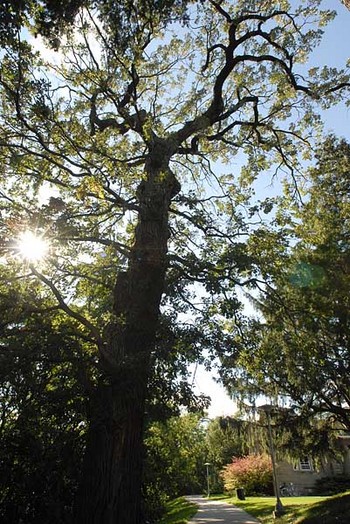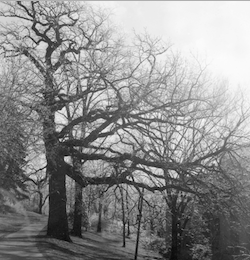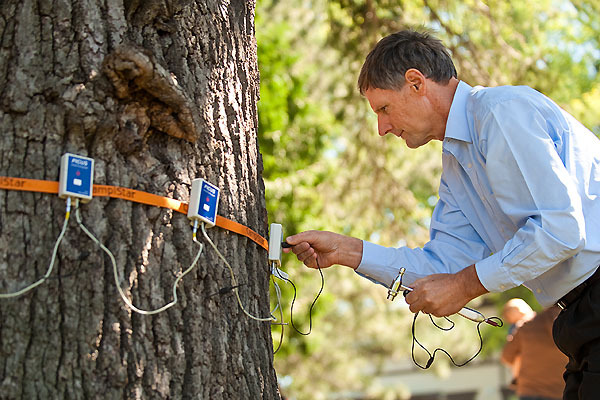Last stand of the President’s Oak: A tree’s life remembered
A worker saws the iconic 300-year-old President’s Oak, a tree that was located just south of the Observatory Hill Office Building (La Follette School of Public Affairs, not shown) and north of Nancy Nicholas Hall (background) Jan. 14.
After a tall and green life, Quercus macrocarpa, better known to friends as the President’s Oak, was taken down on Jan. 14, 2015, following a lengthy illness.
The native bur oak was once a tree without a name. It was born about three centuries ago, at least 100 years before the university, into the open savannah emblematic of Wisconsin’s pre-settlement landscape. Likely it sprouted naturally from an acorn provided by another centuries-old bur oak nearby.

The President’s Oak in 2006. Washburn Observatory is in the background.
Photo: Michael Forster Rothbart
It grew on a ridge with a perfect view of Lake Mendota, keeping company with nearby Native American burial mounds and witnessing visits by native people for ceremonial events.
As decades passed, the university sprouted around it on Observatory Hill — including a nearby grand residential building, now occupied by the La Follette School of Public Affairs, that originally housed several university presidents. Thus, the oak got its moniker.
Tales of the tree abound. Perhaps the most famous is that Union troops training at nearby Camp Randall during the Civil War used it for gunnery practice. A good story for sure, but Daniel Einstein, historic and cultural resources manager at UW–Madison, is skeptical. What’s more likely, Einstein suggests, is that large oak trees were also present on the south side of Observatory Hill. Those trees (with a steep slope behind them) were perhaps the true targets. When the trees were eventually removed, the story about target practice “over by the hill,” just moved up the slope to the largest remaining tree on the hill.

The President’s Oak in an undated historical view looking east.
Image courtesy of UW–Madison Archives
Though its exact age isn’t known, the President’s Oak was by far the oldest tree on campus.
Recent years had been particularly hard on it. Drought, harsh winters and the inevitable aging process took their toll. Cables and iron bolts were installed to hold the ailing tree together and limbs were removed to protect passersby.
Bruce Allison, a local consulting arborist and adjunct professor of forestry, used advanced technology to map the inner architecture of the tree and check for decay.
In the end, it wasn’t enough.
Related: Why trees rot from the inside out.
“Much of the main trunk was hollow and we were seeing significant dieback in the upper branches — all signs that it was time to remove the tree in a controlled and safe manner,” says Gary Brown, director of campus planning and landscape architecture.

Bruce Allison performs an acoustic tomography scan on the tree in 2010 to check the density of the wood and detect possible decay.
Children from the nearby UW-Preschool Laboratory gathered to pay their last respects to the tree, singing their own version of “Let it Go” and hugging its trunk.
The President’s Oak is survived by more than 4,000 trees on campus, including 60 bur oaks. It will live on, both in memories and, perhaps, in furniture crafted for Bascom Hall from its wood as well as art projects. Small sections of living branches were taken to graft potential progeny and to plant nearby in hopes of continuing its life into the next several centuries.
Renowned preservationist John Muir sums up its life best:
“A few minutes ago every tree was excited, bowing to the roaring storm, waving, swirling, tossing their branches in glorious enthusiasm like worship. But though to the outer ear these trees are now silent, their songs never cease.”
